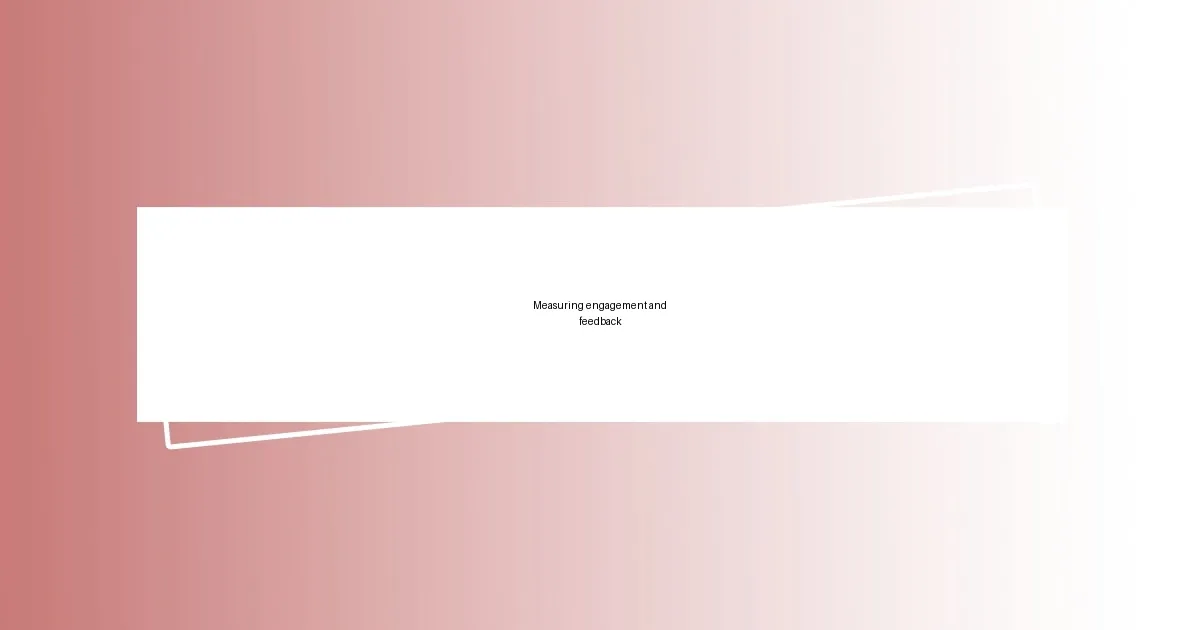Key takeaways:
- Understanding the audience’s needs through empathy enhances event content and fosters a solution-driven experience.
- Incorporating interactive elements, like live polls and Q&A sessions, boosts engagement and creates memorable experiences.
- Choosing user-friendly platforms for promotion and interaction is critical for maximizing attendee engagement.
- Measuring engagement through feedback and real-time interactions helps refine future content strategies effectively.

Understanding your audience’s needs
Understanding your audience’s needs is like tuning into a frequency that resonates with them. I vividly recall a seminar I organized where I initially overlooked the diversity of my audience’s interests. It turned out that a significant portion sought hands-on workshops rather than high-level discussions. Isn’t it intriguing how a single oversight can shift the entire experience?
It’s essential to put yourself in their shoes. I often ask myself, “What challenges are they facing, and how can my event address those?” This approach not only enriches my content but transforms the event into a solution-driven experience for attendees. When I tailored a recent workshop to directly tackle common pain points in my industry, the feedback was overwhelmingly positive.
Empathy plays a crucial role in understanding needs. It’s not just about gathering information; it’s about connecting emotionally with the audience. I’ve learned that sharing my own struggles related to the topic creates an instant bond, making them feel less isolated in their experiences. Can you imagine how much more impactful it is when someone feels understood and supported?

Planning content for engagement
Planning content for engagement requires a thoughtful and strategic approach. I remember a time I was developing materials for a networking event and decided to include interactive elements, such as live polls and breakout sessions. The result? Attendees were not just passive listeners but actively participated, creating a buzz that echoed throughout the venue. When people feel involved, it fosters connections that far surpass anything I could have imagined.
Here are a few key strategies I’ve found effective in planning engaging content:
- Incorporate Interactive Elements: Games, polls, or Q&A sessions make the audience feel part of the action.
- Create Varied Formats: Mix up presentations, panels, and hands-on workshops to cater to different learning styles.
- Align with Audience Interests: Conduct pre-event surveys to gauge topics of interest and tailor content accordingly.
- Encourage Networking: Design icebreaker activities that make it easy for attendees to connect.
- Leverage Storytelling: Share relatable personal experiences that evoke emotions, making your points resonate deeply.
Engaging content isn’t just about what you share; it’s how you connect with the audience. Finding that balance has made a profound difference in how my events unfold.

Integrating interactive elements effectively
Integrating interactive elements effectively can truly elevate an event experience. One time, I decided to incorporate a live quiz during a conference. Not only did this spark friendly competition, but it also encouraged participants to engage with the content actively. Watching the audience lean in and exchange excitement over their scores was a rewarding sight. I believe these moments create lasting memories.
In my experience, the key to successful integration is to ensure that interactions feel seamless and purposeful. For instance, during one of my events, we used an app that allowed attendees to ask questions anonymously. This resulted in a flood of inquiries, many of which touched on deep-rooted concerns. It fostered a genuine dialogue, breaking down the traditional barriers between speaker and audience. How empowering it feels when people are invited to share their thoughts freely!
To truly resonate, it’s crucial to blend these interactive elements thoughtfully into your agenda. I once attended a workshop that combined hands-on activities with group discussions. This blend not only catered to various learning styles but also allowed for rich conversations that flowed naturally. The participants left feeling not just informed but transformed and connected. It brings me joy to know that even small adjustments can lead to significant impact.
| Interactive Element | Benefits |
|---|---|
| Live Polls | Encourages real-time feedback and engagement. |
| Q&A Sessions | Facilitates direct communication and clarifies doubts. |
| Breakout Sessions | Allows for deeper discussions in smaller, comfortable groups. |
| Interactive Apps | Empowers attendees to participate actively and ask questions. |

Choosing the right platforms
Choosing the right platforms can make or break your event’s engagement levels. For instance, I once opted for a social media platform as the primary tool for pre-event buzz and audience interaction. The excitement it generated was palpable, with people sharing their expectations and connecting with each other long before the actual event began. It made me wonder: how often do we miss the chance to harness online communities to build genuine excitement?
Moreover, selecting platforms that resonate with your audience is essential. I remember attending a seminar that utilized a niche networking app tailored for professionals in my field. The instant connection it fostered among participants was incredible! It reminded me that understanding where your audience spends their time online can lead to meaningful interactions that extend beyond the event itself.
Don’t forget to consider the accessibility and user-friendliness of your chosen platforms. In one of my earlier events, I made the mistake of using a complicated registration system that frustrated potential attendees. Watching their confusion unfold made me realize that easy access to information – from event details to interaction opportunities – is key to encouraging engagement. Have you ever dropped an event simply because the platform was too challenging to navigate? I know I have.

Promoting your event content
Promoting your event content effectively is all about creating buzz and anticipation. I remember one event where I utilized a teaser video highlighting key speakers and what attendees could expect. The response was electric—people shared it across their networks, and suddenly, our registration numbers started climbing. It made me realize just how powerful visual storytelling can be in generating excitement.
Social media is another avenue I’ve found invaluable for promotion. Last year, I started a countdown on platforms like Instagram and Twitter, using engaging graphics and snippets from our speakers. The interaction was unbelievable; followers commented and shared their thoughts, creating a sense of community before the event even kicked off. Have you ever thought about how a well-timed post can give your audience something to look forward to? The magic truly lies in fostering those connections early.
Lastly, don’t underestimate the impact of direct communication. Sending personalized emails to potential attendees can create a feeling of exclusivity. I once crafted an invitation that acknowledged each recipient’s previous attendance at our events, tailoring the message to resonate with their experiences. It felt less like a generic outreach and more like a genuine conversation, encouraging more people to join in. Have you tapped into the art of personalized engagement in your promotional strategy? It’s an approach that can lead to powerful results.

Measuring engagement and feedback
Measuring engagement and gathering feedback is vital for understanding the impact of your event content. After one of my events, I sent out a simple survey to participants, asking about their experiences and what resonated with them. To my surprise, the feedback was overwhelmingly positive, but I also discovered a few areas needing improvement, like the duration of breakout sessions. It reminded me that sometimes the smallest tweaks can enhance engagement significantly, don’t you think?
In another instance, I utilized real-time polling during an event, which was both exciting and revealing. Attendees could instantly express their thoughts on various topics, and viewing their responses on screen created a dynamic interaction. It was fascinating to witness how this instantaneous feedback influenced discussions and kept the energy high. How often do we think about feedback not just as a post-event form but as an ongoing conversation?
I also learned the importance of analyzing social media interactions post-event. I monitored hashtags and comments, which generated a wealth of insights beyond typical surveys. One insightful comment from an attendee about how a particular speaker inspired them stuck with me. Those moments of connection remind me that measuring engagement is not solely about numbers; it’s about understanding the personal stories and emotions that fuel participation. Have you ever considered how these narratives might shape your future events?

Refining future content strategies
Refining content strategies for future events is a process guided by reflection and adaptability. After analyzing feedback from various gatherings, I realized that content relevance plays a crucial role in audience engagement. For example, one year I focused on a theme that resonated with attendees’ current challenges, and the atmosphere was electric. It showed me that staying attuned to the audience’s needs is vital—how often do we really listen to our community’s pulse?
Moreover, I experimented with a mix of content formats, blending traditional presentations with interactive workshops. This shift not only kept participants engaged but also fostered deeper discussions. I recall a session where we broke into small groups to tackle a real-world problem related to our topic; the insights that emerged were invaluable. Have you ever considered how varied formats might enhance your audience’s experience?
Thinking ahead, I also plan to incorporate more storytelling into future content strategies. Sharing personal stories or case studies allows attendees to connect on a deeper level. One time, I shared a challenging moment from my career that resonated with many in the room, leading to an unexpected outpouring of shared experiences. Isn’t it fascinating how vulnerability can bridge gaps and forge stronger connections? It’s a reminder that refining content isn’t just about the facts; it’s about the emotions behind them.














